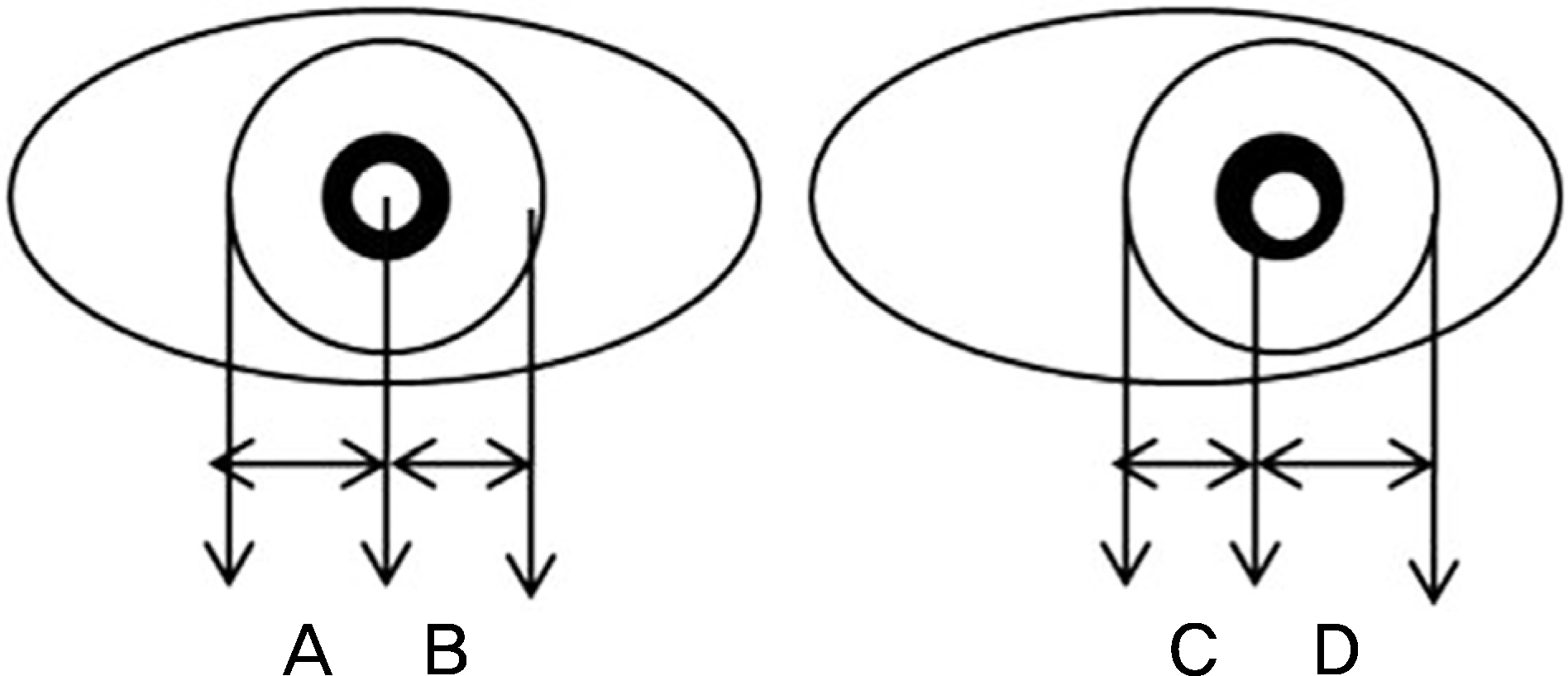Abstract
Purpose
To evaluate the association between ocular dominance, hand dominance and eye deviation in orthophoric and strabismus patients under general anesthesia during surgery.
Methods
The subjects were divided into 2 groups. Group 1 was composed of 38 patients who underwent strabismus surgery and group 2 was composed of 107 patients who underwent non-strabismus surgery under general anesthesia. Best corrected visual acuity (BCVA), dominant hand and fixating eye were obtained before surgery, and ocular dominance was assessed using the hole-in-the-card test. Under general anesthesia, we took a digital photo of both eyes, and the deviating eye was determined. Results: Under general anesthesia, the deviated eye showed no statistically significant correlation to the dominant eye and dominant hand in group I, respectively (p = 0.61, 0.74, respectively). In group II, there was no correlation between the deviated eye and the dominant eye (p = 0.65). The deviated eye also showed no correlation to the dominant hand in group II (p = 0.61). Conclusions: There was no correlation between the dominant and deviated eye under general anesthesia in the strabismus surgery group and the non-strabismus surgery group. Also, there was no correlation between the dominant hand and the deviated eye in patients under general anesthesia in the 2 groups.
Go to : 
References
1. BREININ GM. The position of rest during anesthesia and sleep; electromyographic observations. AMA Arch Ophthalmol. 1957; 57:323–6.

2. Duke-Elder S. System of ophthalmology. 6. St. Louis: C.V. Mosby Co.;1973. p. 96.
3. Coren S, Kaplan CP. Patterns of ocular dominance. Am J Optom Arch Am Acad Optom. 1973; 50:283–92.
4. Porac C, Coren S. Sighting dominance and binocular rivalry. Am J Optom Physiol Opt. 1978; 55:208–13.

5. Porac C, Coren S. Suppressive processes in binocular vision: ocular dominance and amblyopia. Am J Optom Physiol Opt. 1975; 52:651–7.
6. Worth C, Chavasse B. Squint. 9th ed.London: Bailliere, Tindal, and Cox;1959. p. 714.
7. Burford GE. Involuntary eyeball motion during anesthesia and sleep relationship to cortical rhythmic potentials. Anesth Anal. 1941; 20:191–9.

8. Roth A, Speeg-schatz CI. Eye muscle surgery: basic data operative techniques surgical stratergy. Swets and Zeitlinger publishers. Masson Paris. 1995; chap. 1, 4.
9. Omi E, Oguri K, Yoshiya I, Kitamura S. [Eye position of squinting eyes during general anesthesia (author's transl)]. Nihon Ganka Gakkai Zasshi. 1975; 79:540–6.
10. Romano P, Gabriel L. Intraoperative adjustment of eye muscle surgery. Correction based on eye position during general anesthesia. Arch Ophthalmol. 1985; 103:351–3.
11. Lee DS, Kim SY. Eye position of orthophoric patients under general anesthesia. J Korean Ophthalmol Soc. 2001; 42:1303–8.
12. Sidikaro Y, von Noorden GK. Observations in sensory heterotropia. J Pediatr Ophthalmol Strabismus. 1982; 19:12–9.

13. Havertape SA, Cruz OA, Chu FC. Sensory strabismus–eso or exo? J Pediatr Ophthalmol Strabismus. 2000; 38:327–30.

14. Min BM, Min WK, Lee KM, Kim YB. Clinical evaluation of sensory heterotropia. J Korean Ophthalmol Soc. 1989; 30:767–72.
15. Bielschowsky A. Über die relative Ruhelage der Augen. BerVers Deutsch Ophthal Ges. 1913; 39:67–79.
16. Chavasse FB. Worth's Squint or the Binorcular Reflexes and the Treatment of Strabismus. 7th ed.London: Bailliere, Tindall & Cox;1939. p. 519.
17. Knapp P. Divergent deviation. Allen JH, editor. Strabismus Ophthalmic Symposium II. 1st ed.St. Louis: Mosby;1958; chap. 17.
18. Fink WH. The dominant eye: its clinical significance. Arch Ophthalmol. 1938; 19:555–82.
20. Mapp AP, Ono H, Barbeito R. What does the dominant eye dominate? A brief and somewhat contentious review. Percept Psychophys. 2003; 65:310–7.

21. Koo BS, Cho YA. The relationship of dominant eye, dominant hand, and deviated eye in strabismus. J Korean Ophthalmol Soc. 1996; 37:1277–82.
Go to : 
 | Figure 1.Schematic illustration of eye position in the surgical plane of anesthesia. (A) Distance between temporal corneal limbus and corneal reflex in non-deviating eye. (B) Distance between nasal corneal limbus and corneal reflex in non-deviating eye. (C) Distance between nasal corneal limbus and corneal reflex in deviating eye. (D) Distance between temporal corneal limbus and corneal reflex in deviating eye. |
Table 1.
Characteristic of patients in strabismus and non-strabismus group at baseline
| Strabismus surgery (n = 38) |
Non-strabismus surgery (n = 107) |
p-value* |
||
|---|---|---|---|---|
| Ophthalmologic surgery (n = 61) | Non-ophthalmologic surgery (n = 46) | |||
| Age (years) | 7.71 ± 3.19 | 48.23 ± 23.72 | 33.54 ± 22.69 | 0.00* |
| Sex (n) | ||||
| Male | 23 | 29 | 21 | |
| Female | 15 | 32 | 25 | |
| Diagnosis | Exotropia 27 | Retinal disorder 44 | ||
| Esotropia 9 | Lens disorder 4 | |||
| Hypertropia 2 | Lid disorder 9 | |||
| Others 4 | ||||
| BCVA (decimal) | ||||
| Right | 0.92 ± 0.21 | 0.62 ± 0.37 | 0.98 ± 0.08 | 0.00* |
| Left | 0.90 ± 0.21 | 0.53 ± 0.37 | 0.98 ± 0.08 | 0.00* |
| Difference of BCVA (decimal) | 0.03 ± 0.12 | 0.10 ± 0.30 | 0.01 ± 0.03 | 0.01* |
Table 2.
Dominant eye & hand and deviated eye under general anesthesia in strabismus surgery group and non-strabismus surgery group
Table 3.
Association of deviated eye with dominant eye and dominant hand in strabismus surgery group and non-strabismus surgery group
| Strabismus surgery | Non-strabismus surgery | |||
|---|---|---|---|---|
| r ± SE | pvalue* | r ± SE | p-value* | |
| Dominant eye | 0.09 ± 0.16 | 0.74* | −0.44 ± 0.10 | 0.79* |
| Dominant hand | 0.06 ± 0.14 | 0.85* | 0.05 ± 0.13 | 0.54* |




 PDF
PDF ePub
ePub Citation
Citation Print
Print


 XML Download
XML Download